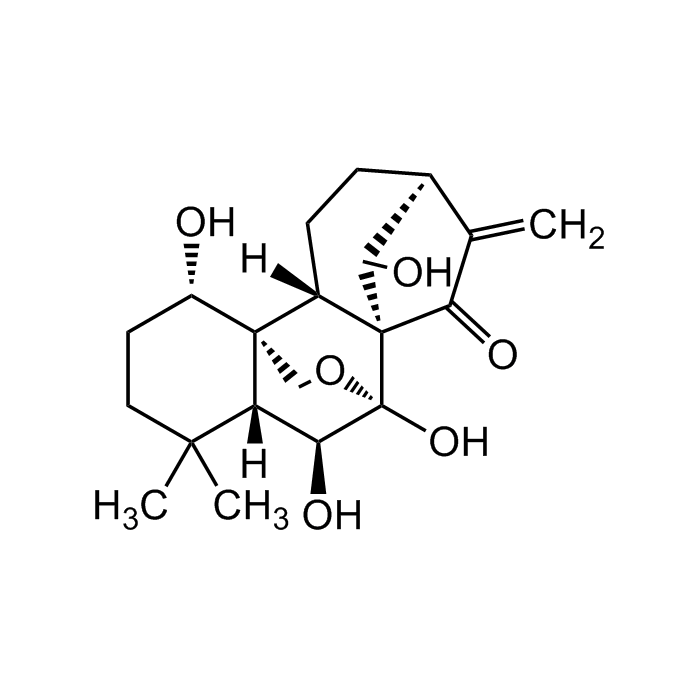Cookie Policy: This site uses cookies to improve your experience. You can find out more about our use of cookies in our Privacy Policy. By continuing to browse this site you agree to our use of cookies.
Chemodex
Oridonin

| Product Details | |
|---|---|
| Synonyms | 7α,20-Epoxy-1α,6β,7,14-tetrahydroxy-Kaur-16-en-15-one, NSC 250682 |
| Product Type | Chemical |
| Properties | |
| Formula |
C20H28O6 |
| MW | 364.43 |
| CAS | 28957-04-2 |
| RTECS | NZ8177000 |
| Source/Host Chemicals | Plant |
| Purity Chemicals | ≥98% (HPLC) |
| Appearance | White to off-white powder. |
| Solubility | Soluble in DMSO (20mg/ml), DMF (20mg/ml) or ethanol (20mg/ml). Insoluble in water. |
| Identity | Determined by 1H-NMR. |
| Declaration | Manufactured by Chemodex. |
| Other Product Data |
Click here for Original Manufacturer Product Datasheet |
| InChi Key | SDHTXBWLVGWJFT-XKCURVIJSA-N |
| Smiles | O[C@@H]1[C@]2(CO3)[C@@]([C@H](O)[C@]3(O)[C@@](C4=O)([C@@H]5O)[C@@]2([H])CC[C@H]5C4=C)([H])C(C)(C)CC1 |
| Shipping and Handling | |
| Shipping | AMBIENT |
| Short Term Storage | +20°C |
| Long Term Storage | +4°C |
| Handling Advice | Protect from light and moisture. |
| Use/Stability | Stable for at least 2 years after receipt when stored at +4°C. |
| Documents | |
| Product Specification Sheet | |
| Datasheet |
 Download PDF Download PDF |
Oridonin is a diterpenoid that has been found in R. rubescens and has anti-inflammatory and anticancer, antimicrobial and neuroprotective properties. The regulatory anticancer mechanisms include induction of apoptosis and autophagy, inhibition of proliferation, inhibition of angiogenesis, cell cycle arrest. It is an inhibitor of the TLR4/p38-MAPK and TLR4/NF-κ signaling pathways and PPARγ. Oridonin is a high affinity inhibitor of NLRP3 inflammasome assembly and activation (Kd = 52.5 nM). It inhibits inflammation in wild-type, but not Nlrp3-/-, mice in a model of high-fat diet-induced type 2 diabetes. Also inhibits glial activation, decreases inflammatory cytokine release, attenuates synaptic loss and improves behavioural deficits in Aβ1-42 treated mice. CRL/SCF RING E3 inhibitor. Inhibits Fbw7 an E3 ubiquitin ligase (CRL/SCF RING) of c-Myc and promotes proteasomal degradation.
(1) T. Ikezoe, et al.; Int. J. Oncol. 23, 1187 (2003) | (2) J.J. Liu, et al.; Ann. Hematol. 83, 691 (2004) | (3) T. Ikezoe, et al.; Mol. Cancer Ther. 4, 578 (2005) | (4) Q. Cui, et al.; J. Pharmacol. Sci. 105, 317 (2007) | (5) H. Wang, et al.; Oncol. Rep. 24, 647 (2010) | (6) H.L. Huang, et al.; Mol. Cancer Ther. 11, 1155 (2012) | (7) Z. Liu, et al.; Cell Prolif. 45, 499 (2012) (Review) | (8) S. Wang, et al.; PLoS One 9, e104745 (2014) | (9) B.A. Owona & H.J. Schluesener; Drugs R.D. 15, 233 (2015) (Review) | (10) S. Wang, et al; PLoS One 11, e0151397 (2016) | (11) L. Tian, et al.; BMC Complement. Altern. Med. 17, 192 (2017) | (12) J. Li, et al.; Int. Immunopharmacol. 55, 9 (2018) | (13) J. Xu, et al.; Molecules 23, E474 (2018) (Review) | (14) H. He, et al.; Nat. Commun. 9, 2550 (2018) | (15) T. Jia, et al.; Int. Immunopharmacol. 69, 382 (2019)





